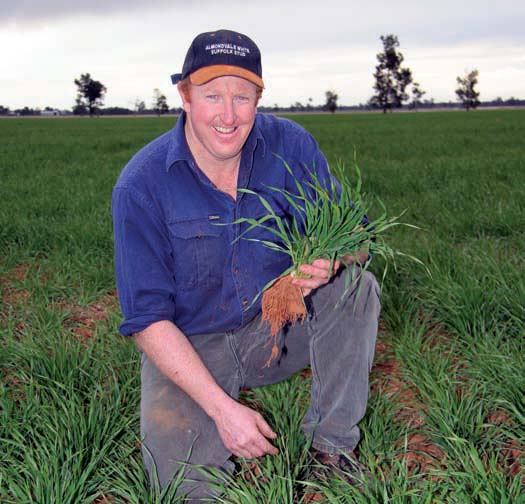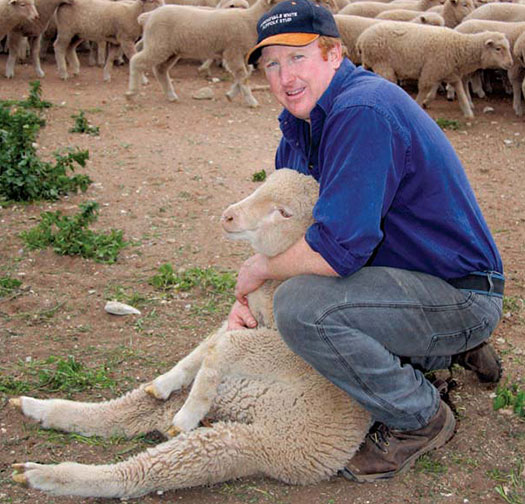
Case
Study
Location
Corobimilla, New South Wales
Crop
Pasture
Forrest and Hall Family, ‘Columbia Park’ and ‘New Park’ Corobimilla NSW
Riverina farmer, Andrew Forrest, has transformed a tired farm into a highly productive property, yielding as well as any in the district after adopting a minimum till biological farming system.
Andrew, his wife, Sue, and his sister and brother-in-law, Kate and Kevin Hall grow 800 ha of wheat, barley, canola and field peas and 100ha of oats for grazing and hay on adjoining properties, ‘Columbia Park’ and ‘New Park’ at Corobimilla, 20 kilometres south-west of Narrandera.
A fifth generation farmer, Andrew grew up on his parents’ property near Corowa. The two couples bought ‘Columbia Park’ in 1994 and then ‘New Park’ seven years later, reuniting what was once a single farm.
The soils on ‘Columbia Park’ were worse for wear after many years of continuous conventional cropping. “The soil was powdery with no structure and would blow, wash and crust pretty easily, which is not uncommon in these red sandy loam soils,” he said.
Their first step in rejuvenating the land was to convert from conventional tillage to a minimum-tillage farming system and then a biological nutrient program.
“It’s not what you see in the first year that counts, it’s what you see over the whole four or five year rotation that’s important”

Andrew Forrest inspects Buloke barley sown two months earlier in marginal moisture at ‘Columbia Park’, Corobimilla, NSW.

Andrew Forrest checks three-month-old White Suffolk-Merino first cross lambs at ‘Columbia Park’, Corobimilla, NSW.
“We wanted to get away from artificial fertilisers, improve our soil structure and make the farm healthier and more in tune with the environment,” he said. “We wanted to keep as much cover on it as we could. “One of our neighbours was getting good pasture growth from a biological nutrient program and his lucerne was responding particularly well, so we decided to give it a go.”
Andrew’s first foray into biological farming was in a paddock that was being sown to canola after completing its pasture phase. The pasture had been sprayed out the year before and the paddock was chemically allowed until BioAgPhos® and lime were applied with a belt spreader in early 2002. Sulphate of ammonia was added a month later. A liquid treatment, BioAg Soil & Seed™, was applied with a boomspray along with a pre-emergent herbicide and zinc sulphate and incorporated when the canola was sown with a reduced rate of MAP fertiliser.
“That canola yielded a bit better than the district average, but it’s not what you see in the first year that counts, it’s what you see over the whole four or five year rotation that’s important,” Andrew said. “We’re trying to get phosphorus, calcium and sulphur levels in the soil up to where they can sustain four or five years of pasture growth without having to topdress.” The current cropping rotation typically sees canola followed by wheat, barley, peas and a final wheat crop or barley under sown with lucerne and clover-based pasture.
“We work the ground once when we bring it out of the pasture phase to establish a seedbed for the canola but apart from that, all the crops are direct-drilled into standing stubble,” Andrew said. “The whole farm has now been treated with BioAg products. The place was pretty much flogged when we bought it, but in a very short time we’ve raised it to at least district average in yield, grain quality and fertility.
“After last year’s dry finish, our wheat yields were pretty ordinary, but they were equal to the district average – and we still managed to strip a lot of crop and cut hay off the rest when most of the district crop was just grazed off. “The soil structure has definitely improved. It’s easier to work, it’s not crusting as much and we’re not getting the wind-blown erosion we used to. Our soil tests would stack up against anything in the district, and our stubble breaks down faster, which means fewer problems at sowing.”
The partnership also runs 1,500 Wanganellablood Merino ewes that are joined to White Suffolk rams for prime lamb production. The Merinos cut an average of eight kilograms of 21.5-22 micron wool last year. “We originally had a self-replacing Merino flock but we didn’t have sufficient sheep to breed enough replacement ewes, so we started using White Suffolk rams for lamb production about 10 years ago,” Andrew said.
“Our lambing rate over the whole scanned and unscanned flock is about 115% this year. That’s pretty good for Merinos, especially given that this has been the hardest year on the stock since we came here.”
“The fertility of our Merino ewes is also improving,” Andrew said. “We scan our ewes and this year about four percent of the scanned sheep were dry compared to eight percent last year. “Our lambing rate over the whole scanned and unscanned flock is about 115% this year. That’s pretty good for Merinos, especially given that this has been the hardest year on the stock since we came here.”
BioAgPhos and lime are applied at the beginning, middle and end of each cropping phase, eliminating the need for topdressing during the pasture phase and ensuring that the soil is brimming with nitrogen, calcium and phosphorus before the cropping program begins.
As a result, pastures recover more quickly after grazing and weeds, such as silver grass, are much less abundant.
Download case study
Download a PDF version of the above case study.

Recent Comments